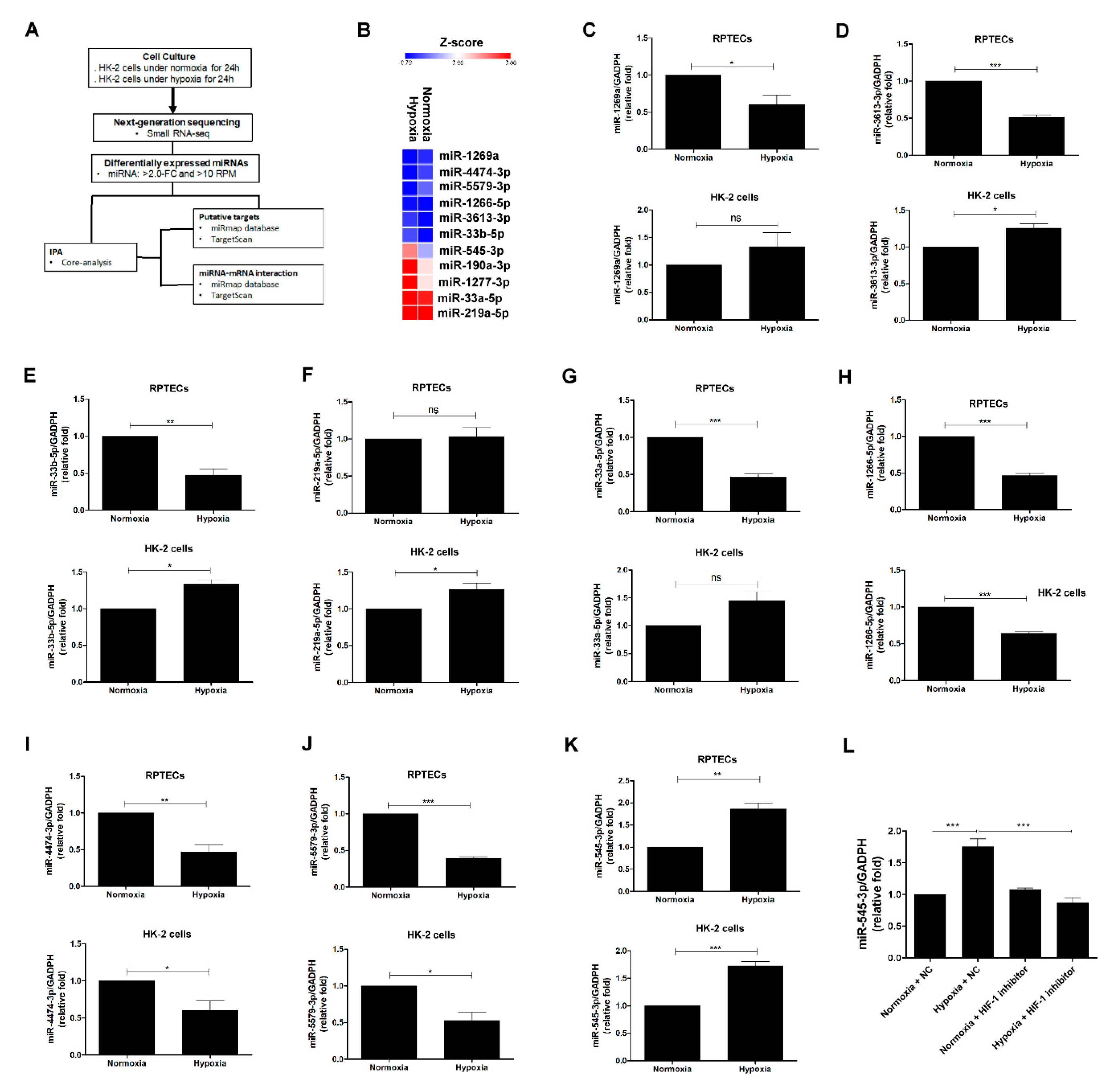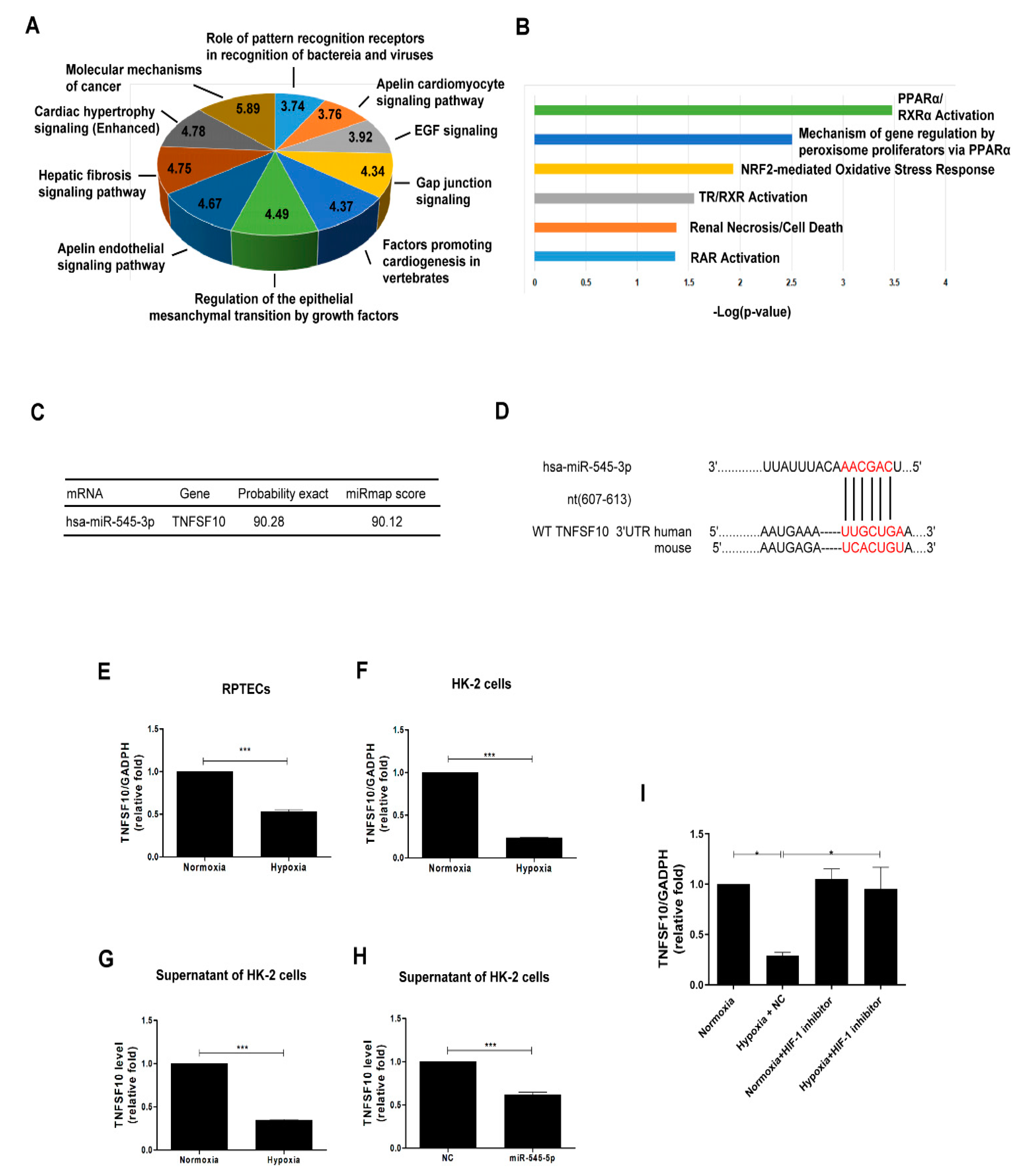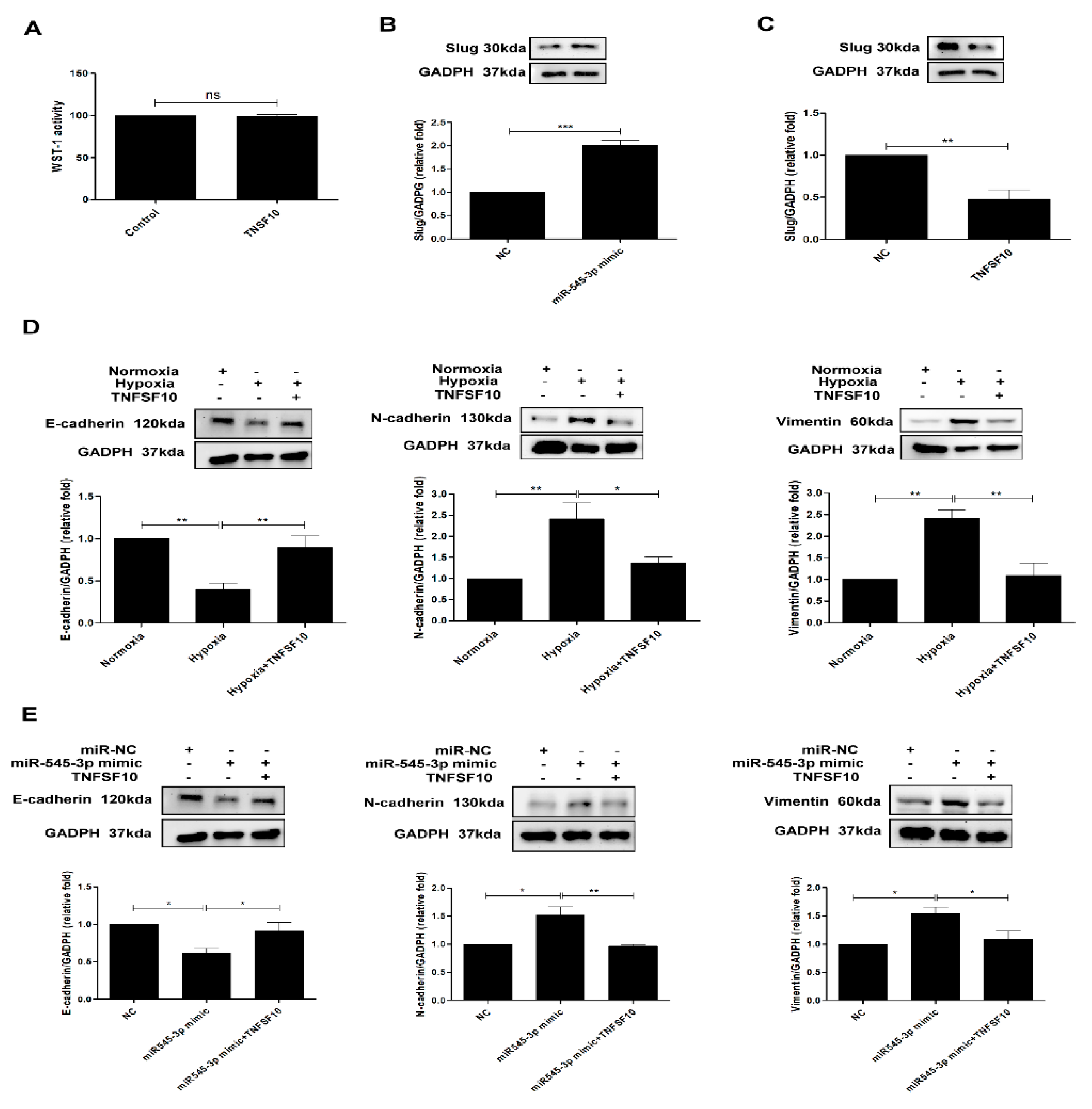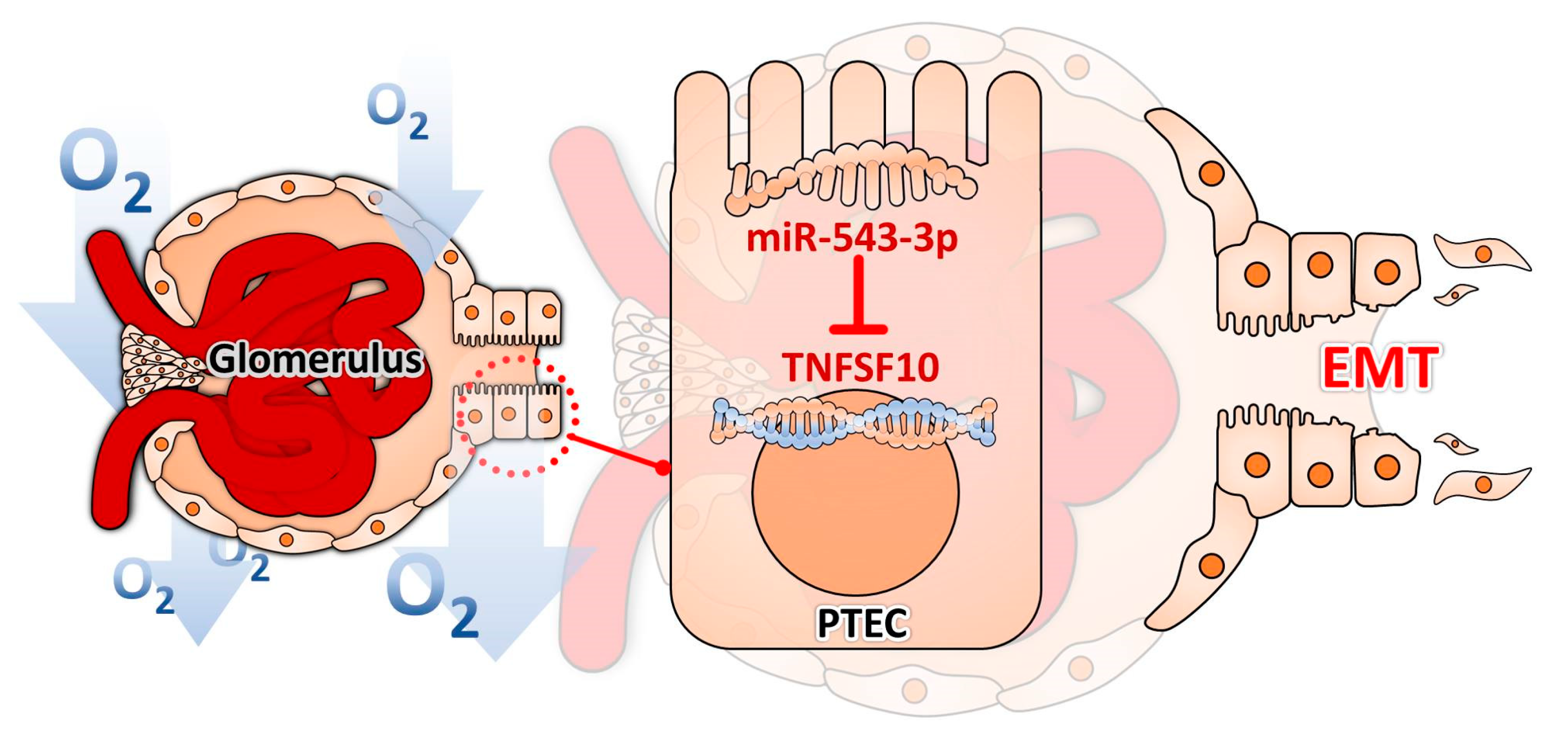Hypoxia-Induced Epithelial-to-Mesenchymal Transition in Proximal Tubular Epithelial Cells through miR-545-3p–TNFSF10
Abstract
:1. Introduction
2. Materials and Methods
2.1. Cell Culture and Morphology Observation
2.2. Western Blot Analysis
2.3. Small RNA Sequencing
2.4. Data Availability
2.5. RNA Isolation, Reverse Transcription, and Quantitative Real Time PCR (Q-PCR)
2.6. Bioinformatics Analysis Tools
2.7. Transient Transfection
2.8. Enzyme-Linked Immunosorbent Assay (ELISA)
2.9. Statistical Analysis
3. Results
3.1. Hypoxia Induces EMT in PTECs
3.2. Identification of miR-545-3p Participating in Hypoxia-Induced EMT in PTECs
3.3. TNFSF10 as a Direct Target of miR-545-3p
3.4. Hypoxia Induces EMT in HK Cells by miR-545-3p–TNFSF10 Modulation
4. Discussion
5. Conclusions
Supplementary Materials
Author Contributions
Funding
Institutional Review Board Statement
Informed Consent Statement
Data Availability Statement
Conflicts of Interest
References
- Liu, M.; Liu, L.; Bai, M.; Zhang, L.; Ma, F.; Yang, X.; Sun, S. Hypoxia-induced activation of Twist/miR-214/E-cadherin axis promotes renal tubular epithelial cell mesenchymal transition and renal fibrosis. Biochem. Biophys. Res. Commun. 2018, 495, 2324–2330. [Google Scholar] [CrossRef]
- Heyman, S.N.; Khamaisi, M.; Rosen, S.; Rosenberger, C. Renal parenchymal hypoxia, hypoxia response and the progression of chronic kidney disease. Am. J. Nephrol. 2008, 28, 998–1006. [Google Scholar] [CrossRef]
- Giaccia, A.J.; Simon, M.C.; Johnson, R. The biology of hypoxia: The role of oxygen sensing in development, normal function, and disease. Genes Dev. 2004, 18, 2183–2194. [Google Scholar] [CrossRef] [PubMed] [Green Version]
- Movafagh, S.; Crook, S.; Vo, K. Regulation of hypoxia-inducible factor-1a by reactive oxygen species: New developments in an old debate. J. Cell Biochem. 2015, 116, 696–703. [Google Scholar] [CrossRef]
- Manotham, K.; Tanaka, T.; Matsumoto, M.; Ohse, T.; Inagi, R.; Miyata, T.; Kurokawa, K.; Fujita, T.; Ingelfinger, J.R.; Nangaku, M. Transdifferentiation of cultured tubular cells induced by hypoxia. Kidney Int. 2004, 65, 871–880. [Google Scholar] [CrossRef] [Green Version]
- Fine, L.G.; Bandyopadhay, D.; Norman, J.T. Is there a common mechanism for the progression of different types of renal diseases other than proteinuria? Towards the unifying theme of chronic hypoxia. Kidney Int. Suppl. 2000, 75, S22–S26. [Google Scholar] [CrossRef] [PubMed] [Green Version]
- Li, Y.; Kang, Y.S.; Dai, C.; Kiss, L.P.; Wen, X.; Liu, Y. Epithelial-to-mesenchymal transition is a potential pathway leading to podocyte dysfunction and proteinuria. Am. J. Pathol. 2008, 172, 299–308. [Google Scholar] [CrossRef] [PubMed] [Green Version]
- Yamaguchi, Y.; Iwano, M.; Suzuki, D.; Nakatani, K.; Kimura, K.; Harada, K.; Kubo, A.; Akai, Y.; Toyoda, M.; Kanauchi, M.; et al. Epithelial-mesenchymal transition as a potential explanation for podocyte depletion in diabetic nephropathy. Am. J. Kidney Dis. 2009, 54, 653–664. [Google Scholar] [CrossRef]
- Higgins, D.F.; Kimura, K.; Bernhardt, W.M.; Shrimanker, N.; Akai, Y.; Hohenstein, B.; Saito, Y.; Johnson, R.S.; Kretzler, M.; Cohen, C.D.; et al. Hypoxia promotes fibrogenesis in vivo via HIF-1 stimulation of epithelial-to-mesenchymal transition. J. Clin. Investig. 2007, 117, 3810–3820. [Google Scholar] [CrossRef]
- Haase, V.H. Oxygen regulates epithelial-to-mesenchymal transition: Insights into molecular mechanisms and relevance to disease. Kidney Int. 2009, 76, 492–499. [Google Scholar] [CrossRef] [Green Version]
- Nallamshetty, S.; Chan, S.Y.; Loscalzo, J. Hypoxia: A master regulator of microRNA biogenesis and activity. Free Radic. Biol. Med. 2013, 64, 20–30. [Google Scholar] [CrossRef] [PubMed] [Green Version]
- Zell, S.; Schmitt, R.; Witting, S.; Kreipe, H.H.; Hussein, K.; Becker, J.U. Hypoxia Induces Mesenchymal Gene Expression in Renal Tubular Epithelial Cells: An in vitro Model of Kidney Transplant Fibrosis. Nephron Extra 2013, 3, 50–58. [Google Scholar] [CrossRef]
- Du, R.; Sun, W.; Xia, L.; Zhao, A.; Yu, Y.; Zhao, L.; Wang, H.; Huang, C.; Sun, S. Hypoxia-induced down-regulation of microRNA-34a promotes EMT by targeting the Notch signaling pathway in tubular epithelial cells. PLoS ONE 2012, 7, e30771. [Google Scholar] [CrossRef] [Green Version]
- Xie, S.; Chen, H.; Li, F.; Wang, S.; Guo, J. Hypoxia-induced microRNA-155 promotes fibrosis in proximal tubule cells. Mol. Med. Rep. 2015, 11, 4555–4560. [Google Scholar] [CrossRef] [PubMed]
- Available online: https://mirmap.ezlab.org (accessed on 15 July 2021).
- Available online: http://www.targetscan.org (accessed on 15 July 2021).
- Tsai, Y.C.; Kuo, M.C.; Hung, W.W.; Wu, L.Y.; Wu, P.H.; Chang, W.A.; Kuo, P.L.; Hsu, Y.L. High Glucose Induces Mesangial Cell Apoptosis through miR-15b-5p and Promotes Diabetic Nephropathy by Extracellular Vesicle Delivery. Mol. Ther. 2020, 28, 963–974. [Google Scholar] [CrossRef]
- Lewington, A.J.; Cerda, J.; Mehta, R.L. Raising awareness of acute kidney injury: A global perspective of a silent killer. Kidney Int. 2013, 84, 457–467. [Google Scholar] [CrossRef] [Green Version]
- Chitwood, D.H.; Timmermans, M.C. Target mimics modulate miRNAs. Nat. Genet. 2007, 39, 935–936. [Google Scholar] [CrossRef]
- Changjun, L.; Feizhou, H.; Dezhen, P.; Zhao, L.; Xianhai, M. MiR-545-3p/MT1M axis regulates cell proliferation, invasion and migration in hepatocellular carcinoma. Biomed. Pharmacother. 2018, 108, 347–354. [Google Scholar] [CrossRef]
- Liu, Z.; Dou, C.; Yao, B.; Xu, M.; Ding, L.; Wang, Y.; Jia, Y.; Li, Q.; Zhang, H.; Tu, K.; et al. Ftx non coding RNA-derived miR-545 promotes cell proliferation by targeting RIG-I in hepatocellular carcinoma. Oncotarget 2016, 7, 25350–25365. [Google Scholar] [CrossRef] [PubMed] [Green Version]
- Liu, X.; Li, C.; Zhu, J.; Li, W.; Zhu, Q. Dysregulation of FTX/miR-545 signaling pathway downregulates Tim-3 and is responsible for the abnormal activation of macrophage in cirrhosis. J. Cell Biochem. 2018, 120, 2336–2346. [Google Scholar] [CrossRef] [PubMed]
- Xiao, X.; He, Z.; Tong, S.; Dai, L.; Xiao, Q.; Qin, Z.; Lin, T.; Xu, H. lncRNA XIST Knockdown Suppresses Hypoxia/Reoxygenation (H/R)-Induced Apoptosis of H9C2 Cells by Regulating miR-545-3p/G3BP2. IUBMB Life 2021. [Google Scholar] [CrossRef]
- Tan, M.; Bei, R. Circ_0091702 serves as a sponge of miR-545-3p to attenuate sepsis-related acute kidney injury by upregulating THBS2. J. Mol. Histol. 2021. [Google Scholar] [CrossRef]
- Hu, Q.; Zen, W.; Zhang, M.; Wang, Z.; Cui, W.; Liu, Y.; Xu, B. Long Non-Coding RNA CASC2 Overexpression Ameliorates Sepsis-Associated Acute Kidney Injury by Regulating MiR-545-3p/PPARA axis. Surg. Res. 2021, 265, 223–232. [Google Scholar] [CrossRef]
- Shi, X.; Ma, W.; Li, Y.; Wang, H.; Pan, S.; Pan, Y.; Xu, C.; Li, L. CircPRKCI relieves lipopolysaccharide-induced HK2 cell injury by upregulating the expression of miR-545 target gene ZEB2. Biofactors 2020, 46, 475–486. [Google Scholar] [CrossRef]
- Fang, Y.; Lu, J.; Wang, X.; Wu, H.; Mei, S.; Zheng, J.; Xu, S.; Lenahan, C.; Chen, S.; Zhang, J.; et al. HIF-1alpha Mediates TRAIL-Induced Neuronal Apoptosis via Regulating DcR1 Expression Following Traumatic Brain Injury. Front. Cell Neurosci. 2020, 14, 192. [Google Scholar] [CrossRef]
- Harashima, N.; Takenaga, K.; Akimoto, M.; Harada, M. HIF-2alpha dictates the susceptibility of pancreatic cancer cells to TRAIL by regulating survivin expression. Oncotarget 2017, 8, 42887–42900. [Google Scholar] [CrossRef]
- Voelkel-Johnson, C. TRAIL-mediated signaling in prostate, bladder and renal cancer. Nat. Rev. Urol. 2011, 8, 417–427. [Google Scholar] [CrossRef] [PubMed]
- Aggarwal, B.B. Signalling pathways of the TNF superfamily: A double-edged sword. Nat. Rev. Immunol. 2003, 3, 745–756. [Google Scholar] [CrossRef]
- Bernardi, S.; Voltan, R.; Rimondi, E.; Melloni, E.; Milani, D.; Cervellati, C.; Gemmati, D.; Celeghini, C.; Secchiero, P.; Zauli, G.; et al. TRAIL, OPG, and TWEAK in kidney disease: Biomarkers or therapeutic targets? Clin. Sci. 2019, 133, 1145–1166. [Google Scholar] [CrossRef] [Green Version]
- Nalli, A.D.; Brown, L.E.; Thomas, C.L.; Sayers, T.J.; Porco, J.A., Jr.; Henrich, C.J. Sensitization of renal carcinoma cells to TRAIL-induced apoptosis by rocaglamide and analogs. Sci. Rep. 2018, 8, 17519. [Google Scholar] [CrossRef] [PubMed] [Green Version]
- Toffoli, B.; Fabris, B.; Bartelloni, G.; Bossi, F.; Bernardi, S. Dyslipidemia and Diabetes Increase the OPG/TRAIL Ratio in the Cardiovascular System. Mediat. Inflamm. 2016, 2016, 6529728. [Google Scholar] [CrossRef] [Green Version]
- Tornese, G.; Iafusco, D.; Monasta, L.; Agnoletto, C.; Tisato, V.; Ventura, A.; Zauli, G.; Secchiero, P. The levels of circulating TRAIL at the onset of type 1 diabetes are markedly decreased in patients with ketoacidosis and with the highest insulin requirement. Acta Diabetol. 2014, 51, 239–246. [Google Scholar] [CrossRef] [PubMed]
- Lorz, C.; Benito-Martin, A.; Boucherot, A.; Ucero, A.C.; Rastaldi, M.P.; Henger, A.; Armelloni, S.; Santamaria, B.; Berthier, C.C.; Kretzler, M.; et al. The death ligand TRAIL in diabetic nephropathy. J. Am. Soc. Nephrol. 2008, 19, 904–914. [Google Scholar] [CrossRef] [Green Version]
- Okuyama, S.; Komatsuda, A.; Wakui, H.; Aiba, N.; Fujishima, N.; Iwamoto, K.; Ohtani, H.; Sawada, K. Up-regulation of TRAIL mRNA expression in peripheral blood mononuclear cells from patients with minimal-change nephrotic syndrome. Nephrol. Dial. Transplant. 2005, 20, 539–544. [Google Scholar] [CrossRef] [PubMed] [Green Version]
- Adachi, T.; Sugiyama, N.; Gondai, T.; Yagita, H.; Yokoyama, T. Blockade of Death Ligand TRAIL Inhibits Renal Ischemia Reperfusion Injury. Acta Histochem. Cytochem. 2013, 46, 161–170. [Google Scholar] [CrossRef] [PubMed] [Green Version]
- Sari, F.; Yalcin, A.D.; Genc, G.E.; Sarikaya, M.; Bisgin, A.; Cetinkaya, R.; Gumuslu, S. Autosomal Dominant Polycystic Disease is Associated with Depressed Levels of Soluble Tumor Necrosis Factor-Related Apoptosis-Inducing Ligand. Balk. Med. J. 2016, 33, 512–516. [Google Scholar] [CrossRef]
- Nguyen, V.; Cudrici, C.; Zernetkina, V.; Niculescu, F.; Rus, H.; Drachenberg, C.; Rus, V. TRAIL, DR4 and DR5 are upregulated in kidneys from patients with lupus nephritis and exert proliferative and proinflammatory effects. Clin. Immunol. 2009, 132, 32–42. [Google Scholar] [CrossRef] [Green Version]





| Ingenuity Canonical Pathways | −Log (p-Value) | Ratio | Molecules |
|---|---|---|---|
| Role of Pattern Recognition Receptors in Recognition of Bacteria and Viruses | 3.74 | 0.0764 | DDX58, EDA, MAPK8, PIK3C2A, PIK3C3, PRKCA, PRKD3, RNASEL, SYK, TLR8, TNFSF10 |
| Apelin Cardiomyocyte Signaling Pathway | 3.76 | 0.0918 | ARNT, GNAI3, MAPK8, MYLK, PIK3C2A, PIK3C3, PRKCA, PRKD3, SLC9A8 |
| EGF Signaling | 3.92 | 0.127 | JAK1, MAPK8, PIK3C2A, PIK3C3, PRKCA, RPS6KB1, SOS2 |
| Gap Junction Signaling | 4.34 | 0.0722 | CSNK1G3, GNAI3, GRIA4, GRIK3, HTR2A, PIK3C2A, PIK3C3, PPP3R2, PRKAR1A, PRKCA, PRKD3, SOS2, TUBB, TUBB1 |
| Factors Promoting Cardiogenesis in Vertebrates | 4.37 | 0.0828 | BMP8B, FZD6, LRP1, LRP6, MAP3K7, MAPK8, MEF2C, MYOCD, PRKCA, PRKD3, SMAD2, WNT7A |
| Regulation of the Epithelial Mesenchymal Transition by Growth Factors Pathway | 4.49 | 0.0745 | FGF2, FGFR1, HGF, JAK1, LATS1, MAP3K7, MAPK8, PDGFB, PIK3C2A, PIK3C3, SMAD2, SMURF1, SOS2, TNFSF10 |
| Apelin Endothelial Signaling Pathway | 4.67 | 0.0965 | ARNT, GNA13, GNAI3, GNAO1, MAPK8, MEF2C, PIK3C2A, PIK3C3, PRKCA, PRKD3, RPS6KB1 |
| Hepatic Fibrosis Signaling Pathway | 4.75 | 0.0582 | FGF2, FGFR1, FZD6, GNAI3, ITGA2, JAK1, LRP6, MAP3K7, MAPK8, MYLK, PDGFB, PIK3C2A, PIK3C3, PRKAR1A, PRKCA, PRKD3, PTCH1, RPS6KB1, SMAD2, SOS2, WNT7A |
| Cardiac Hypertrophy Signaling (Enhanced) | 4.78 | 0.0525 | EDA, FGF2, FGFR1, FZD6, GNA13, GNAI3, H2BW2, IFNAR1, IL10RA, IL4R, ITGA2, MAP3K7, MAPK8, MEF2C, MYOCD, PDE3B, PIK3C2A, PIK3C3, PPP3R2, PRKAR1A, PRKCA, PRKD3, RPS6KB1, TNFSF10, WNT7A |
| Molecular Mechanisms of Cancer | 5.89 | 0.0625 | BMP8B, E2F7, FZD6, GNA13, GNAI3, GNAO1, H2BW2, ITGA2, JAK1, LRP1, LRP6, MAP3K7, MAPK8, PIK3C2A, PIK3C3, PRKAR1A, PRKCA, PRKD3, PSEN1, PTCH1, SMAD2, SOS2, TFDP1, WNT7A |
| Ingenuity Toxicity Lists | −Log (p-Value) | Ratio | Molecules |
|---|---|---|---|
| RAR Activation | 1.37 | 0.0417 | DUSP1, GTF2H5, MAPK8, PRKAR1A, PRKCA, PRKD3, SMAD2, TRIM24 |
| Renal Necrosis/Cell Death | 1.38 | 0.0318 | CARD8, DUSP1, FGF2, GLS, GNA13, HGF, HSPA1A/HSPA1B, IPPK, LRP6, MAPK8, PRKCA, PSEN1, PTCH1, SLK, TNFSF10, UNC5C, USP14, VPS13A |
| TR/RXR Activation | 1.55 | 0.0595 | PDE3B, PIK3C2A, PIK3C3, STRBP, SYT2 |
| NRF2-mediated Oxidative Stress Response | 1.93 | 0.0472 | CUL3, CYP2C19, MAP3K7, MAPK8, PIK3C2A, PIK3C3, PRKCA, PRKD3, UBE2K, USP14 |
| Mechanism of Gene Regulation by Peroxisome Proliferators via PPARα | 2.51 | 0.0745 | DUSP1, HSPA1A/HSPA1B, MAP3K7, PDGFB, PRKAR1A, PRKCA, SOS2 |
| PPARα/RXRα Activation | 3.48 | 0.0667 | CAND1, CKAP5, CLOCK, CYP2C19, GPD2, MAP3K7, MAPK8, MEF2C, PRKAR1A, PRKCA, SMAD2, SOS2 |
| Top Diseases and Functions | Score | Focus Molecules | Molecules in Network |
|---|---|---|---|
| Cell Cycle, Cell Death and Survival, Free Radical Scavenging | 26 | 21 | Ap1, CARD8, CD3, DDX58, ELP1, FGF2, HMGB1, HTR7, IFNBeta, IFN type 1, IKK (complex), IL1, IL10RA, IL12 (complex), IL4R, Immunoglobulin, Jnk, LDL, MAP1LC3, MAP3K7, MAPK8, MYLK, NFkB (complex), PI3K (complex), PP2A, PRKCA, RNASEL, RPS6KB1, RTF1, SETBP1, TFAM, TLR8, TNFSF10, UHMK1, ZC3HAV1 |
Publisher’s Note: MDPI stays neutral with regard to jurisdictional claims in published maps and institutional affiliations. |
© 2021 by the authors. Licensee MDPI, Basel, Switzerland. This article is an open access article distributed under the terms and conditions of the Creative Commons Attribution (CC BY) license (https://creativecommons.org/licenses/by/4.0/).
Share and Cite
Kuo, M.-C.; Chang, W.-A.; Wu, L.-Y.; Tsai, Y.-C.; Hsu, Y.-L. Hypoxia-Induced Epithelial-to-Mesenchymal Transition in Proximal Tubular Epithelial Cells through miR-545-3p–TNFSF10. Biomolecules 2021, 11, 1032. https://doi.org/10.3390/biom11071032
Kuo M-C, Chang W-A, Wu L-Y, Tsai Y-C, Hsu Y-L. Hypoxia-Induced Epithelial-to-Mesenchymal Transition in Proximal Tubular Epithelial Cells through miR-545-3p–TNFSF10. Biomolecules. 2021; 11(7):1032. https://doi.org/10.3390/biom11071032
Chicago/Turabian StyleKuo, Mei-Chuan, Wei-An Chang, Ling-Yu Wu, Yi-Chun Tsai, and Ya-Ling Hsu. 2021. "Hypoxia-Induced Epithelial-to-Mesenchymal Transition in Proximal Tubular Epithelial Cells through miR-545-3p–TNFSF10" Biomolecules 11, no. 7: 1032. https://doi.org/10.3390/biom11071032






